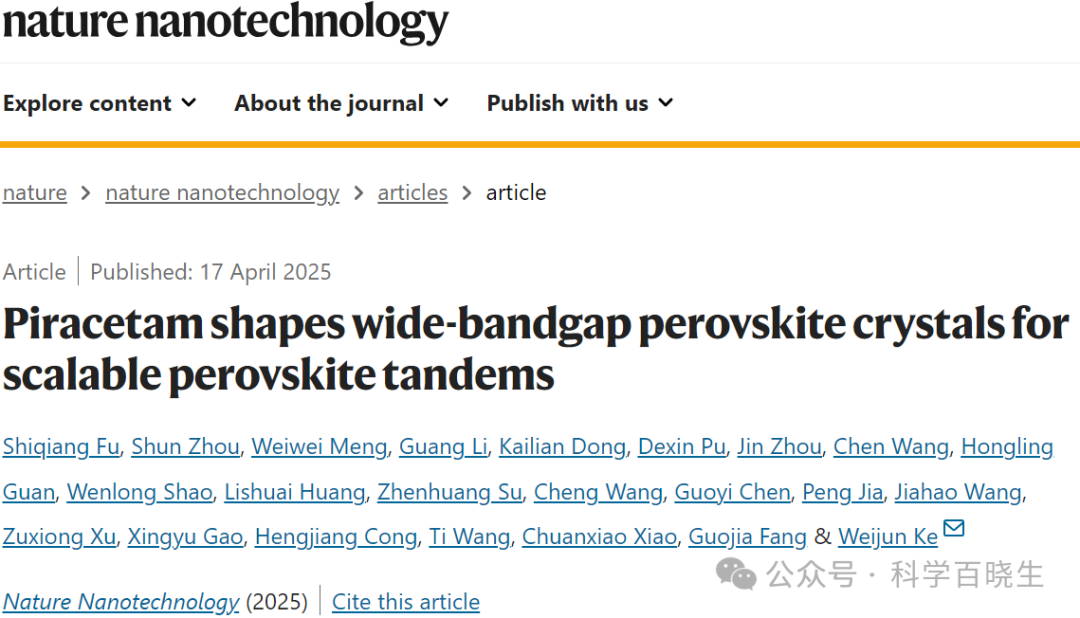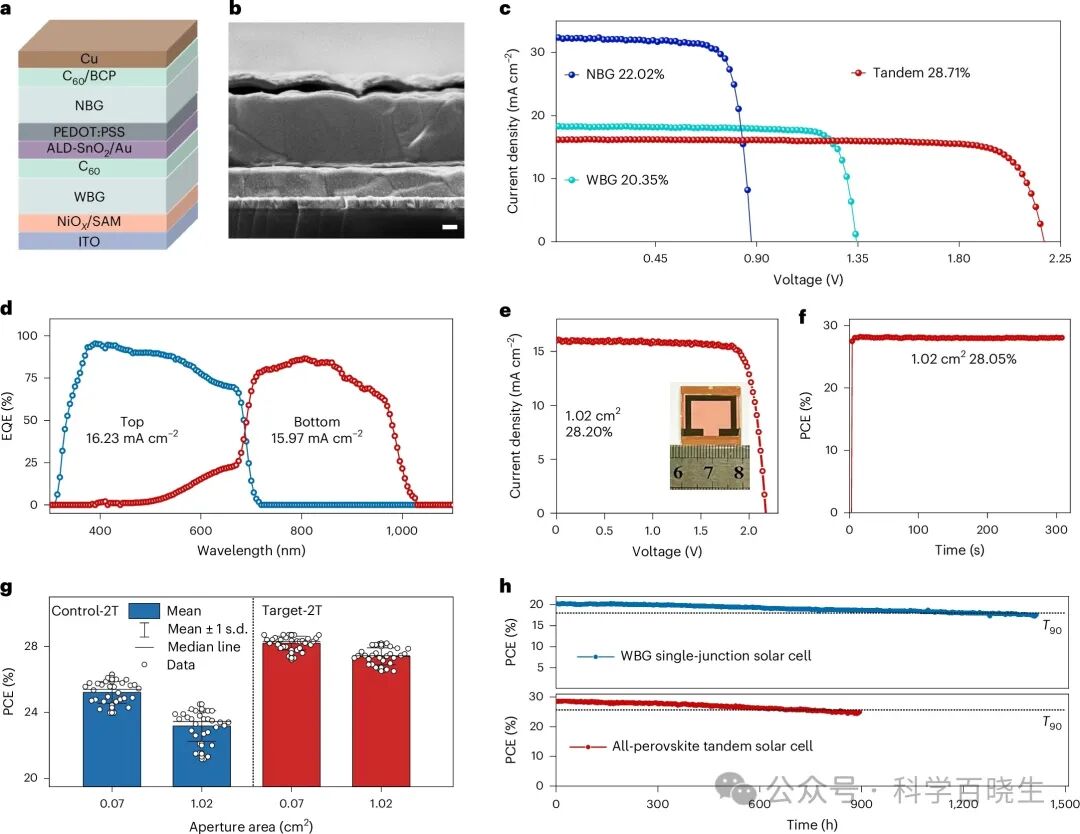

▲First Author:Shiqiang Fu, Shun Zhou, Weiwei Meng, Guang Li
Corresponding Author:Weijun Ke
Affiliation:Wuhan University
DOI:10.1038/s41565-025-01899-z
Research Background
All-perovskite tandem solar cells (TSCs) exhibit exceptional performance and broad application potential. However, the significant difference in power conversion efficiency (PCE) between small-area devices and large-area (>1 cm²) devices remains a major obstacle to the commercialization of all-perovskite tandem solar cells.
Research Problem
This study developed a dedicated crystal modifier, Piracetam, for wide bandgap perovskite materials, successfully constructing efficient large-area tandem devices by homogenizing the top wide bandgap sub-cell structure. The amide and pyrrolidone groups in the Piracetam molecule can precisely regulate the nucleation process of perovskite, inducing the formation of large-sized grains, (110)-oriented, high crystallinity, and uniform optoelectronic properties. During the subsequent annealing process, this molecule further removes residual PbI₂ and in situ generates one-dimensional (Pi)PbI₃ (Pi=Piracetam) perovskite nanoneedle structures at the grain boundaries and surfaces. Based on this, a single-junction solar cell with a bandgap of 1.77 eV achieved a certified open-circuit voltage of 1.36 V and 20.35% PCE. The fabricated single-junction two-electrode all-perovskite tandem solar cells achieved 28.71% (steady state 28.55%, certified 28.13%) and 28.20% (steady state 28.05%, certified 27.30%) PCE at aperture areas of 0.07 cm² and 1.02 cm², with an efficiency loss of only 0.51%. This strategy demonstrates universality across various perovskite components, enhancing the efficiency of 1.56 eV bandgap single-junction cells from 23.56% to 25.71%. This method provides an effective pathway for the scalable fabrication of high-efficiency all-perovskite tandem solar cells.

Figure 1| Growth mechanism of WBG perovskite films
Key Points:
1.This paper selects Piracetam as a modifier with a clear design intent: this non-volatile multifunctional chemical reagent can significantly smooth the film surface, promote large grain formation, optimize the orientation and optoelectronic uniformity of wide bandgap perovskite (FA₀.₈Cs₀.₂PbI₁.₈Br₁.₂, FA=formamidinium) and induce low-dimensional material generation. When Piracetam is added to the perovskite precursor solution, its molecules can interact with uncoordinated Pb²⁺ ions and suppress vacancy formation. Notably, the short hydrogen bonds formed between Piracetam and formamidinium cations effectively inhibit the generation of FA vacancies, while its adsorption can reduce deep-level defect states. Nuclear magnetic resonance spectra confirm the interaction and hydrogen bond formation between Piracetam and perovskite. It is important to emphasize that the photovoltaic performance of perovskite solar cells is closely related to crystal plane orientation; regulating the precursor solution with specific ligand additives can promote favorable orientation and reduce trap state density. Figure 1a-b systematically elucidates the mechanism by which Piracetam aids in the formation of high-quality wide bandgap perovskite films: this molecule tends to accumulate around perovskite grains, preferentially adsorbing on the (110) crystal plane, effectively suppressing grain tilt during film growth, ultimately forming a uniform perovskite film primarily oriented in the (110) direction with micron-sized grain sizes.
2.This paper reveals the mechanism by which Piracetam regulates the crystal plane orientation of wide bandgap perovskite through density functional theory (DFT) calculations (Figure 1c-d). In the original sample, the surface energies (Es) of the (100) and (110) crystal planes are 0.37 J m⁻² and 0.33 J m⁻² (Figure 1e), indicating that these two crystal planes are in a thermodynamic equilibrium state during nucleation/growth, leading to no specific orientation advantage for wide bandgap perovskite. However, binding energy (Eb) analysis shows that the adsorption energy of Piracetam on the (110) crystal plane (-1.54 eV) is significantly lower than that on the (100) crystal plane (-1.19 eV) (Figure 1f), and this selective adsorption promotes rapid growth of the crystal along the (110) crystal plane, ultimately forming high-quality films with preferential exposure of the (110) crystal plane. Piracetam, with its multiple active sites, significantly outperforms similar molecules such as pyrrolidone and 1-ethyl-2-pyrrolidone. Single crystal diffraction analysis further confirms that the amino groups of Piracetam can induce the formation of one-dimensional (Pi)PbI₃ perovskite.

Figure 2| Characterization of WBG perovskite films
Key Points:
1.The crystallization process of wide bandgap perovskite is extremely complex, with crystal orientation being a key parameter for assessing film quality. Through in situ PL, X-ray diffraction (XRD), and pole figure testing, it was found that Piracetam can promote the ordered growth of films along the (110) crystal plane and enhance crystallinity throughout the film formation process. In situ grazing incidence wide-angle X-ray scattering (GIWAXS) shows that the control group films immediately exhibit weak and isotropic scattering rings for (100) and (110) crystal planes after the addition of anti-solvent; whereas the modified group films show strong preferential orientation with high-intensity concentrated distribution of the (110) Debye-Scherrer ring in the qz direction (out-of-plane direction), indicating the presence of favorable growth. Experimental observations reveal that the introduction of Piracetam significantly accelerates the crystallization process of perovskite (Figure 2a-c), promoting crystallization of the (110) crystal plane. As the concentration of the additive increases, the intensity of the (110) crystal plane diffraction peak gradually increases (Figure 2d), while the (100) crystal plane peak shows the opposite trend.
2.Notably, when the concentration of Piracetam reaches 15 mg ml⁻¹, a new diffraction peak belonging to one-dimensional (Pi)PbI₃ appears at ~9.5°, confirming that this molecule is not incorporated into the perovskite lattice. The formation of the one-dimensional structure has a temporal specificity: the characteristic peak of (Pi)PbI₃ appears only after about 250 seconds of annealing (after the perovskite has fully crystallized) (Figure 2c), and scanning electron microscopy reveals bright one-dimensional needle-like structures at the film surface/grain boundaries, with residual PbI₂ completely converted. Time-of-flight secondary ion mass spectrometry (TOF-SIMS) confirms that Piracetam is primarily enriched at the film surface, indicating that the one-dimensional structure preferentially forms at the surface/grain boundaries. This reveals a unique action process: Piracetam acts as a scaffold to regulate orientation and crystallization rate in the early crystallization stage, and later transforms into one-dimensional materials at the surface/grain boundaries.
3.Fourier transform infrared spectroscopy (FTIR) and X-ray absorption near-edge structure analysis reveal that the carbonyl characteristic peak of Piracetam shifts from 1,652 cm⁻¹ to 1,667 cm⁻¹ (Figure 2e), confirming its effective passivation of uncoordinated Pb²⁺ defects through the C=O group interaction with perovskite; the characteristic peak of the C=N bond shifts from 1,710 cm⁻¹ to 1,716 cm⁻¹, suggesting that formamidinium iodide (FAI) may form hydrogen bonds with the additive, which is consistent with nuclear magnetic resonance spectra. Additionally, the modified films exhibit stronger Pb-O coordination and weaker Pb-I bonding (Supplementary Figure 23), resulting from the interaction of Piracetam with lead atoms in the perovskite.

Figure 3| Performance of single-junction WBG perovskite solar cells
Key Points:
1.Based on the significant enhancement of perovskite film performance by Piracetam, this paper fabricated single-junction wide bandgap solar cells (Figure 3a). This additive significantly improved the device’s open-circuit voltage (Voc), fill factor (FF), and power conversion efficiency (PCE) (Figure 3b,d,e). After adding Piracetam, Voc increased from 1.27 V to 1.34 V, PCE increased from 18.51% to 20.35% (Figure 3b). The short-circuit current density (Jsc) obtained from the integral of the external quantum efficiency (EQE curve was 17.93 mA cm⁻² (control group) and 18.25 mA cm⁻² (modified group) (Figure 3c), which highly correlates with the J-V test results. After tracking the maximum power point (MPP) for 300 seconds, the steady-state PCE stabilized at 18.41% (control group) and 20.23% (modified group), with a certified efficiency of 19.72% and Voc 1.36 V.
2.The performance enhancement is attributed to the significant suppression of carrier recombination: the Voc–light intensity slope of the modified group device decreased from 1.63 kBT/q to 1.28 kBT/q (Figure 3f), indicating a significant reduction in defect-assisted recombination. The transient photovoltage decay slows down while the transient photocurrent decay accelerates, confirming a reduction in non-radiative recombination and accelerated interface carrier extraction. Piracetam reduces the trap-filled limit voltage (VTFL) from 0.45 V to 0.13 V, and the trap state density decreases from 7.04×10¹⁵ cm⁻³ to 2.03×10¹⁵ cm⁻³ (Figure 3g). The higher built-in voltage (1.15 V vs 1.05 V) promotes charge separation, combined with the upward shift of the Fermi level (-4.73 eV vs -4.77 eV, Figure 3h) and optimization of the conduction band position (-4.02 eV vs -3.89 eV), collectively contributing to the enhancement of Voc. Kelvin probe force microscopy further validates this band regulation effect.

Figure 4| Performance of two-terminal all-perovskite tandem solar cells
Key Points:
1.Based on the breakthrough of wide bandgap sub-cells, we successfully developed efficient two-terminal all-perovskite tandem cells (2T TSC) (Figure 4a,b). The champion device with an area of 0.07 cm² achieved a PCE of 28.71% (Voc=2.18 V, Jsc=16.19 mA cm⁻², FF=81.35%) (Figure 4c), and the EQE integral current was 16.23 mA cm⁻² (wide bandgap) and 15.97 mA cm⁻² (narrow bandgap) (Figure 4d), and the steady-state efficiency after tracking the MPP for 300 seconds reached 28.55%. Third-party certification shows a reverse scan efficiency of 28.13%, and steady-state efficiency of 27.63%. The large-area device of 1.02 cm² also performed excellently: PCE 28.20% (steady state 28.05%), Voc2.17 V, Jsc 16.04 mA cm⁻², FF 81.05% (Figure 4e,f), and the certified efficiency is 27.30%. Statistical data (Figure 4g) shows that the average PCE of the modified group for 0.07 cm² and 1.02 cm² devices is 28.20±0.41% and 27.41±0.51%, while the control group is only 25.21±0.66% and 23.18±0.93%. Piracetam reduces the efficiency difference between small and large devices from 2.03% to 0.79%, with the champion device showing a difference of 0.51% (28.71% vs 28.20%) setting a record for the smallest difference in tandem devices. This improvement in uniformity stems from the excellent optoelectronic uniformity of the wide bandgap film and the large, smooth grains ensuring the deposition of the top cell. Devices fabricated using the blade-coating method also performed outstandingly, demonstrating industrial application potential.
Conclusion and Outlook
In summary, this paper developed a Piracetam crystal modification strategy, successfully fabricating wide bandgap films with preferential orientation, low defects, high crystallinity, and ultra-smooth surfaces, while in situ generating one-dimensional (Pi)PbI₃ perovskite to further enhance performance. This strategy significantly reduces Voc losses, achieving record efficiencies for both wide bandgap single-junction cells and all-perovskite tandem cells. Notably, the introduction of Piracetam essentially eliminates the size effect of tandem devices, achieving high efficiency in both 0.07 cm² (certified 28.13%) and 1.02 cm² (certified 27.30%) devices. Despite the progress, large-size tandem components still face challenges such as phase separation and increased ionic migration. Future efforts should focus on developing low-bromine component wide bandgap sub-cells, narrow bandgap sub-cells without PEDOT:PSS, stable tunneling layers, and scalable deposition processes, combined with advanced interface engineering strategies, to promote the continuous development of all-perovskite tandem technology.
Original link:https://www.nature.com/articles/s41565-025-01899-z